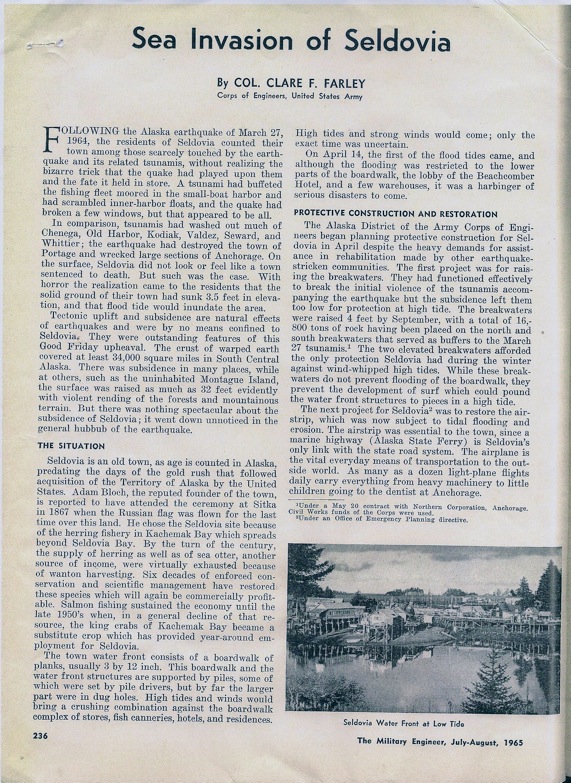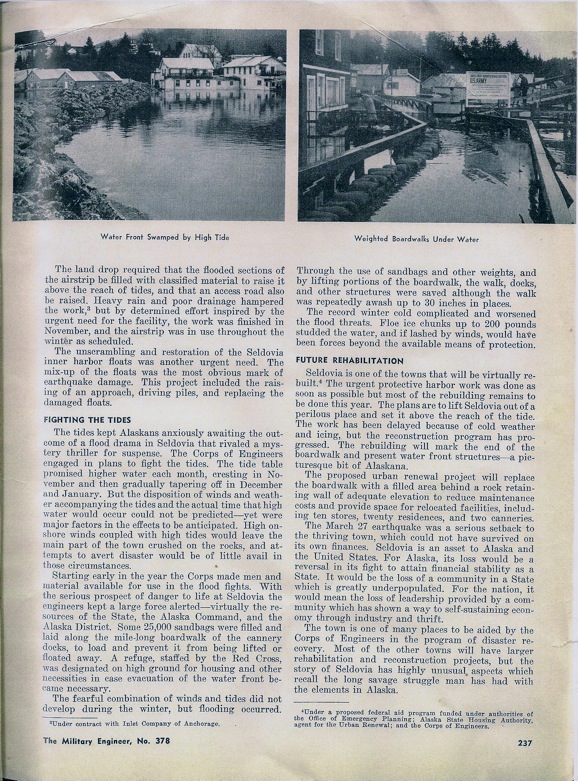Article originally published in the July-August 1965 issue of The Military Engineer; Vol. 57, No. 378. Reprinted with permission of the Society of American Military Engineers (www.same.org).

Rebuilding Seldovia


A transcription of the text in the article follows below:
Page 1
Following the Alaska earthquake of March 27, 1964, the residents of Seldovia counted their town among those scarcely touched by the earthquake and its related tsunamis, without realizing the bizarre trick that the quake had played upon them and the fate it held in store. A tsunami had buffeted the fishing fleet moored in the small-boat harbor and had scrambled inner-harbor floats, and the quake had broken a few windows, but that appeared to be all.
In comparison, tsunamis had washed out much of Chenega, Old Harbor, Kodiak, Valdez, Seward, and Whittier; the earthquake had destroyed the town of Portage and wrecked large sections of Anchorage. On the surface, Seldovia did not look or feel like a town sentenced to death. But such was the case. With horror the realization came to the residents that the solid ground of their town had sunk 3.5 feet in elevation and that flood tide would inundate the area.
Tectonic uplift and subsidence are natural effects of earthquakes and were by no means confined to Seldovia. They were outstanding features of this Good Friday upheaval. The crust of warped earth covered at least 34,000 square miles in South Central Alaska. there was subsidence in many places, while at others, such as the uninhabited Montague Island, the surface was raised as much as 32 feet evidently with violent rending of the forests and mountainous terrain. But there was nothing spectacular about the subsidence of Seldovia; it went down unnoticed in the general hubbub of the earthquake.
The Situation
Seldovia is an old town, as age is counted in Alaska, predating the days of the gold rush that followed acquisition of the Territory of Alaska by the united States. Adam Bloch, the reputed founder of the town, is reported to have attended the ceremony at Sitka in 1867 when the Russian flag was flown for the last time over this land. He chose the Seldovia site because of the herring fishery in Kachemak Bay which spreads beyond Seldovia Bay. By the turn of the century, the supply of herring as well as of sea otter, another source of income, were virtually exhausted because of wanton harvesting. Six decades of enforced conservation and scientific management have restored these species which will again be commercially profitable. Salmon fishing sustained the economy until the late 1950’s when, in a general decline of that resource, the king crabs of Kachemak Bay became a substitute crop which has provided year-around employment for Seldovia.
The town water front consists of a boardwalk of planks, usually 3 by 12 inch. This boardwalk and the water front structures are supported by piles, some of which were set by pile drivers, but by far the larger part were in dug holes. High tides and winds would bring a crushing combination against the boardwalk complex of stores, fish canneries, hotels, and residences. High tides and strong winds would come; only the exact time was uncertain.
On April 14, the first of the flood tides came, and although the flooding was restricted to the lower parts of the boardwalk, the lobby of the Beachcomber Hotel, and a few warehouses, it was a harbinger of serious disasters to come.
Protective Construction and Restoration
The Alaska District of the Army Corps of Engineers began planning protective construction for Seldovia in April despite the heavy demands for assistance in rehabilitation made by other earthquake-stricken communities. The first project was for raising the breakwaters. They had functioned effectively to break the initial violence of the tsunamis accompanying the earthquake but the subsidence left them too low for protection at high tide. The breakwaters were raised 4 feet by September, with a total of 16,800 tons of rock having been placed on the north and south breakwaters that served as buffers to the March 27 tsunamis.1 The two elevated breakwaters afforded the only protection Seldovia had during the winter against wind-whipped high tides. While these breakwaters do not prevent flooding of the boardwalk, they prevent the development of surf which could pound the water front structures to pieces in a high tide.
The next project for Seldovia2 was to restore the airstrip, which was now subject to tidal flooding and erosion. The airstrip was essential to the town, since a marine highway (Alaska State Ferry) is Seldovia’s only link with the state road system. The airplane is the vital everyday means of transportation to the outside world. As many as a dozen light-plane flights daily carry everything from heavy machinery to little children going to the dentist at Anchorage.
1 Under a May 20 contract with Northern Corporation, Anchorage. Civil Works funds of the Corps were used.
2 Under an Office of Emergency Planning directive.
Page 2
The land drop required that the flooded sections of the airstrip be filled with classified material to raise it about the reach of tides, and that an access road also be raised. Heavy rain and poor drainage hampered the work,3 but by determined effort inspired by the urgent need for the facility, the work was finished in November, and the airstrip was in use throughout the winter as scheduled.
The unscrambling and restoration of the Seldovia inner harbor floats was another urgent need. The mix-up of the floats was the most obvious mark of earthquake damage. This project included the raising of an approach, driving piles, and replacing the damaged floats.
Fighting the Tides
The tides kept Alaskans anxiously awaiting the outcome of a flood drama in Seldovia that rivaled a mystery thriller for suspense. The Corps of Engineers engaged in plans to fight the tides. The tide table promised higher water each month, cresting in November and then gradually tapering off in December and January. But the disposition of winds and weather accompanying the tides and the actual time that high water would occur could not be predicted -yet were major factors in the effects to be anticipated. High onshore winds coupled with high tides would leave the main part of the town crushed on the rocks, and attempts to avert disaster would be of little avail in those circumstances.
Starting early in the year the Corps made men and material available for use in the flood fights. With the serious prospect of danger to life at Seldovia the engineers kept a large force alerted -virtually the resources of the State, the Alaska Command, and the Alaska District. Some 25,000 sandbags were filled and laid along the mile-long boardwalk of the cannery docks, to load and prevent it from being lifted or floated away. A refuge, staffed by the Red Cross, was designated on high ground for housing and other necessities in case evacuation of the water front became necessary.
The fearful combination of winds and tides did not develop during the winter, but flooding occurred. Through the use of sandbags and other weights, and by lifting portions of the boardwalk, the walk, docks, and other structures were saved although the walk was repeatedly awash up to 30 inches in places.
The record winter cold complicated and worsened the flood threats. Floe ice chunks up to 200 pounds studded the water, and if lashed by winds, would have been forces beyond the available means of protection.
Future Rehabilitation
Seldovia is one of the towns that will be virtually rebuilt.4 The urgent protective harbor work was done as soon as possible but most of the rebuilding remains to be done this year. The plans are to lift Seldovia out of a perilous place and set it above the reach of the tide. The work has been delayed because of cold weather and icing, but the reconstruction program has progressed. The rebuilding will mark the end of the boardwalk and present water front structures -a picturesque bit of Alaskana.
The proposed urban renewal project will replace the boardwalk with a filled area behind a rock retaining wall of adequate elevation to reduce maintenance costs and provide space for relocated facilities, including ten stores, twenty residences, and two canneries.
The March 27 earthquake was a serious setback to the thriving town, which could not have survived on its own finances. Seldovia is an asset to Alaska and the United States. For Alaska, its loss would be a reversal in its fight to attain financial stability as a State. It would be the loss of a community in a State which is greatly underpopulated. For the nation, it would mean the loss of leadership provided by a community which has shown a way to self-sustaining economy through industry and thrift.
The town is one of many places to be aided by the Corps of Engineers in the program of disaster recovery. Most of the other towns will have larger rehabilitation and reconstruction projects, but the story of Seldovia has highly unusual aspects which recall the long savage struggle man has had with the elements in Alaska.
3 Under contract with Inlet Company of Anchorage
4 Under a proposed federal aid program funded under authorities of the Office of Emergency Planning; Alaska State Housing Authority, agent for the Urban Renewal; and the Corps of Engineers.



